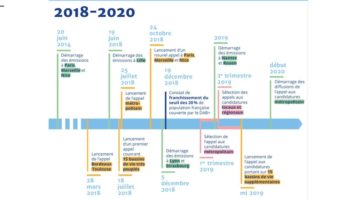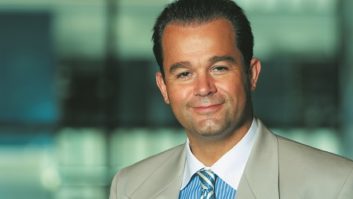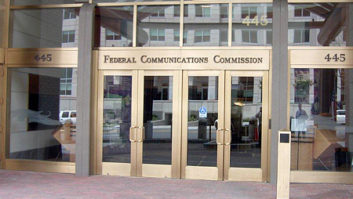LAS VEGAS — In his first appearance before attendees as the Executive Vice President and Chief Technology Officer of NAB, Kevin Gage challenged engineers to gaze beyond the traditional broadcast horizon and seek out technology to connect with consumers more closely. “We’re operating in an environment of rapid deployment and constant development,” said Gage, who warned broadcasters to become proactive and “take the lead, or someone else will.”
Meanwhile, C-Net Editor-at-Large Brian Cooley calls the age we’re living in the “post-PC” era, with smartphones, tablets, connected TVs and connected cars the hot gadgets, at least for the near future. Connected cars are on his top 10 list for tech, behind connected TVs and the smartphone. He characterizes the latter as the “main computing device for the world.”
Seventy percent of new cars have connected dashboards. The days of putting in “a CD deck with AM/FM and HD and you’re fine” are over, warned Cooley.
Here are radio highlights from this year’s NAB Show in Las Vegas.
Smulyan: ‘This Is the Start of a Process’

A prototype cellphone made by ZTE with an FM HD Radio chip displays an interactive ad. Photo by Jim Peck. Several events at and after NAB renewed attention on broadcaster efforts to encourage the use of FM chips in mobile devices.
Research in Motion introduced the BlackBerry Curve 9320 smartphone, which includes built-in FM radio, its third model with FM this year. NAB released a study that it says shows the chip issue is gaining traction among consumers. A meeting on Capitol Hill in April delved in FM chips; broadcast participants say they were left hopeful.
“This is the start of a process,” Emmis Communications CEO Jeff Smulyan told Radio World.
Rep. Gus Bilirakis, R-Fla., called for the private meeting with members of the broadcast, cable and wireless industries. He chairs the House Subcommittee on Subcommittee on Emergency Preparedness, Response and Communications. NAB’s Gordon Smith, Florida Association of Broadcasters’ Pat Roberts, Clear Channel’s Jeff Littlejohn, Cris Guttman-McCabe of CTIA-the wireless Association and congressional staffers attended, as did a representative of the cable industry.
AT&T and Verizon were invited but didn’t come; however they are members of CTIA, which was present.
Smulyan and a NAB spokesman made clear the chip discussions don’t center on a mandate. They believe events will shake out with a negotiated settlement among industry parties. Smulyan, iBiquity Digital and NAB have pressed carriers for a while on the issue. Carriers repeatedly have said consumers aren’t interested in the feature.
“We are asking cell carriers to voluntarily add or activate radio chips, in part because of radio’s demonstrated role as a lifeline service in times of emergency,” said an NAB spokesman.
Broadcasters now believe they have more to offer carriers, after the announcement at the NAB Show of a smaller, more power-efficient HD Radio chip and radio’s ability to close the so-called “backchannel” (see below).
“I think if the carriers realize they can offload some of the spectrum use onto us, that’s valuable to them,” Smulyan said.
NAB and Smulyan said this issue is the number one radio priority for the association.
More discussions are expected, possibly including congressional hearings. Bilirakis plans more meetings on the topic. Smulyan said broadcasters have been approached by the House and Senate Commerce Committees, as well as the Senate Homeland Security & Governmental Affairs Committee.
NAB: More Cellphone Owners Would Pay
A poll fielded by Harris Interactive for NAB indicates that four out of five adults who own a cellphone would consider paying a small, one-time fee to hear FM on their device. Two thousand survey participants were asked about a fee of 30 cents, estimated cost of a microchip.
Eighty-one percent of cellphone owners would consider paying that to access local FM stations through a device, compared to 76 percent in a similar survey in 2012.
Local weather and music are the top reasons survey participants would listen to their local stations on their cell phones.
Cellphone With FM HD Chip Unveiled
Representatives of core proponents working on getting FM HD Radio chips embedded into mobile phones and other devices unveiled a prototype cellphone manufactured by ZTE, as well as an HD Radio app and a backend system to insert and track ads and associated data all the way from automation system to broadcast.
“In 2012, a car is a smartphone with four wheels,” said iBiquity Digital Bob Struble. IBiquity, Emmis Interactive, Intel and BIA/Kelsey were tasked by NAB Labs a year ago to nourish an HD Radio smartphone “ecosystem.”
The proponents say they’ve closed the so-called backchannel, creating a system that makes it possible for a consumer to interact with an FM HD Radio station through his or her mobile device.
Emmis Interactive calls the broadcast insertion system TagStation. It pairs HD Radio broadcasts with the phone’s data channel to deliver features like couponing, geo-location ads and other features.
Emmis Interactive founder and Co-President Rey Mena says this provides a more interactive experience than radio currently can. It also incorporates Artist Experience, in which album art and other images are synched with HD Radio audio, and other features.
The point was to make the HD Radio experience for the user interactive and standardize the experience so user and advertisers know what to expect from station to station, Mena added. “This changes the game for HD,” Mena told Radio World.
With the updated HD Radio app, visuals on the phone look like they would with a streamed audio product, helping radio keep up with other personalized audio in the dash and other mobile devices.
As envisioned by proponents, a consumer with an HD FM-equipped smartphone and associated app would listen to an HD station. By clicking on a thunderbolt-shaped “action button” on the device, the user can perform a variety of functions, from tagging songs for purchase, placing a phone call or visiting a website, to saving a coupon QR code for a later purchase.
With these actions, audio content has the opportunity to be supplemented with rich interactive content synchronized to the station’s broadcast. TagStation, Emmis Interactive’s mobile traffic system that powers this experience, delivers this enhanced mobile experience to the device via the smartphone’s data connection. This hybrid technology utilizes the efficiency of broadcast delivery for audio content while enhancing the experience with interactive elements.
At the station, with TagStation, personnel can see the music or ads coming in from the automation system. They will have, for example, the ability to change the associated image and other metadata, as well as track what consumers do with those ads or songs.
Emmis Communications Chairman and CEO Jeff Smulyan has been trying to convince carriers to embed and activate FM HD Radio chips in mobile devices for about four years. He said, “We think this gives us the opportunity to compete in every appliance out there,” including cellphones, media players, tablets and cars.
The next step is convincing carriers to go along with the concept. Smulyan said that is the priority for the radio industry and NAB. Asked when the new cellphones could be in stores, Smulyan said “soon.”
“This is a 21st century user experience,” Smulyan said.
GM First to Debut Artist Experience
Chevrolet, GMC and Buick will be the first American automotive brands to offer the HD Radio “Artist Experience” feature; it will be standard on the new Traverse, Acadia and Enclave crossover utility vehicles. The new vehicles are likely to be available this fall.
Artist Experience synchronizes images, such as album art and station logos, with the HD Radio program audio on the receiver display. Stations that are implementing AE, notably Clear Channel, Greater Media and Beasley, plan to have that capability operating by this summer, according to iBiquity Digital President/CEO Bob Struble in an interview. That’s a little later than the estimated Q1 start.
With this announcement, 28 automakers offer HD Radio technology as standard or an option, according to the technology developer. Struble said that every 15 seconds, a car is sold that contains HD Radio technology.
Those car sales, plus purchases in portable, tabletop and aftermarket auto HD Radio product categories mean that now 7 million HD Radio receivers have been sold to-date, Struble told Radio World.
EAS Text-to-Speech Now Allowed

Tom Beers, at microphone, is chief of the policy division of the Public Safety & Homeland Security Bureau. He says about 40% of stations had not yet sent the FCC their reports on last fall’s national EAS test. Next to him are Mark Lucero, chief of FEMA IPAWS engineering, and Sharon Tinsley, president of the Alabama Broadcasters Association. Photo by Jim Peck. Also in the news, both during and after the convention, was emergency alerting.
The FCC has changed its Part 11 rules governing EAS so that broadcasters may use text-to-speech functions for the Common Alerting Protocol delivery of alerting messages if they wish to do so. The agency officially deferred a longer-term decision on this question but made the change in the meantime after hearing from the industry about it.
Publication in the Federal Register triggered the modification, which went into effect May 7.
The commission previously had banned TTS, saying it didn’t have a lot of information on the record to do otherwise, according to Tom Beers, chief of the Policy Division for the FCC’s Public Safety & Homeland Security Bureau.
He asked for a show of hands in the EAS session room to judge how many people were “chagrined or distressed” at the text-to-speech ban. Virtually all — some 50 or so broadcasters, public safety officials and vendors involved in alerting — raised their hands.
FEMA, NAB and EAS equipment manufacturers had lobbied the agency to change its stance. Without the use of TTS, they said, some equipment might pass along alert tones with no audio or distorted audio.
FCC Mulls Options on Missing EAS Test Reports
Also on the EAS front, federal regulators believe there will be another national test, though not this year. Meanwhile they’re still trying to get some stations to report results from last November’s test.
FEMA Integrated Public Alert and Warning System Division Director Antwane Johnson said officials hope to have all data in and analyzed before scheduling another national test.
The FCC is trying to decide what to do about stations that didn’t send in results. Beers said enforcement action is possible, although he stressed that no decisions have been made about that. He estimated that only about 60 percent of stations and cable systems had complied.
The FCC’s electronic reporting system lacked a validation function, compounding confusion among stations about whether the agency had received their reports, Beers said. It wasn’t clear whether the commission has a list of non-filers. To check if the commission did receive a station’s results, Beers recommended that broadcasters email [email protected].
Members of the National Alliance of State Broadcasters Associations have offered to work with state broadcast associations to obtain responses.
The deadline for broadcasters to have Common Alerting Protocol-compliant EAS gear operational at their stations is the end of June. Federal regulators indicated that the deadline probably will not be extended again.
FEMA IPAWS officials said the agency is working with third-party developers like Google, Pandora and AOL to distribute IPAWS EAS alerts.
FCC Begins to Make LPFM/Translator Decisions
Shortly after the show, the FCC shone a light on its formula for determining how many FM translators and LPFMs can be allocated in “spectrum-challenged” markets as well as areas that have enough spectrum for both services.
The commission also released an online LPFM channel finder tool.
Media Bureau Chief Peter Doyle said consulting engineers now have access to the FCC’s software and other information so they can identify potential channel combinations in those markets.
The commission also has capped at 50 the number of translator applications it will process for one licensee nationally, and imposed a market-based cap of one application per applicant for some 156 markets.
The agency has indicated that many translator applications in spectrum-squeezed markets would be dismissed in order to create opportunities to license new LPFMs. Melodie Virtue of Garvey Schubert Barer said that of the 6,500 pending FM translator applications, about 1,000 would be eligible for grant and the others would be dismissed according to the agency’s new processing guidelines.
The idea of releasing the newly-released software and data, Doyle said, is to give “everyone clarity so they can figure out which ones to focus on,” meaning the pending 6,500 translator applications, he told Radio World.
The FCC will issue a public notice announcing a deadline by which applicants must select which FM translator applications they’d want to have processed that fit within the caps.
Arbitron Begins Smartphone Measurement
Arbitron’s Mobile division launched a syndicated “opt-in research panel” in the U.S. to produce data about how consumers use them.
The service, Arbitron Mobile Trends Panels, relies on software meters on each device. In the U.S., the company set up a panel of 6,000 smartphone and tablet users recruited in November.
The idea is to provide clients like marketers and content providers with info about how mobile consumers are acting as they use apps, surf, use social media and shop. The meter also provides data on what ads consumers are exposed to, how they act on those ads and how they use devices to communicate.
The service measures reach, frequency, use and consumer engagement. Arbitron says its measurement technology can serve real-time, context-sensitive questionnaires to a user’s mobile device. The feature is designed for custom research studies of the user experience or ad effectiveness.
To be included, individuals must be at least 18. They voluntarily install the Arbitron Mobile on-device meter app on a smartphone or tablet.
With the addition of this syndicated service in the U.S., Arbitron Mobile operates syndicated mobile research panels in six countries: United States, United Kingdom, Finland, Denmark, France and Germany.
Arbitron Begins Smartphone Measurement
Arbitron’s Mobile division launched a syndicated “opt-in research panel” in the U.S. to produce data about how consumers use them.
The service, Arbitron Mobile Trends Panels, relies on software meters on each device. In the U.S., the company set up a panel of 6,000 smartphone and tablet users recruited in November.
The idea is to provide clients like marketers and content providers with info about how mobile consumers are acting as they use apps, surf, use social media and shop. The meter also provides data on what ads consumers are exposed to, how they act on those ads and how they use devices to communicate.
The service measures reach, frequency, use and consumer engagement. Arbitron says its measurement technology can serve real-time, context-sensitive questionnaires to a user’s mobile device. The feature is designed for custom research studies of the user experience or ad effectiveness.
To be included, individuals must be at least 18. They voluntarily install the Arbitron Mobile on-device meter app on a smartphone or tablet.
With the addition of this syndicated service in the U.S., Arbitron Mobile operates syndicated mobile research panels in six countries: United States, United Kingdom, Finland, Denmark, France and Germany.
SBE Pushes Letter Campaign
The Society of Broadcast Engineers is asking members to write their elected representatives in support of a bill to beef up the technical resources of the FCC.
The bill is H.R. 2102, the FCC Technical Resource Enhancement Act.
SBE President Ralph Hogan has placed a sample letter on the SBE Website: www.sbe.org.
The Tech Act is an important component to ensure first-hand competence at the commission’s policymaking level, according to the SBE, which has pushed actively for the legislation.
The bill would permit each FCC commissioner to appoint an electrical engineer or computer scientist as an additional professional staff assistant, to provide the commissioner with technical consultation and provide technical liaison with the FCC bureaus.
“The Congressional Budget Office estimated late last year that the net cost of this legislation will be ‘insignificant.’ Its value far exceeds the negligible cost, as it will reduce the potential for time-consuming, costly, and sometimes irreversible FCC errors,” the society wrote.
Jamie Barnett Exits FCC
The FCC lost Jamie Barnett, chief of its Public Safety & Homeland Security Bureau, at the end of April. Barnett returned to the Potomac Institute for Policy Studies, a science and technology policy think tank.
David Furth, a deputy bureau chief in PSHSB, is now acting chief.
Barnett came to the FCC in July 2009. He had been a senior research fellow at the Potomac Institute.
During his tenure at the Public Safety & Homeland Security Bureau, Barnett proposed the first nationwide test of the Emergency Alert System, which was conducted Nov. 9, 2011.










